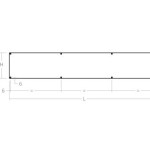Donate Kitchen Cabinets: A Guide to Giving Back and Decluttering
Donating kitchen cabinets is a viable option for homeowners undergoing renovations, remodels, or demolitions. Instead of discarding usable cabinets, donating them offers a multitude of benefits, from environmental responsibility to supporting charitable organizations and potentially receiving tax deductions. This article provides a comprehensive guide to donating kitchen cabinets, outlining the process, benefits, and considerations involved.
Understanding the Benefits of Donating Cabinets
The primary advantage of donating kitchen cabinets lies in its environmental impact. Landfills are frequently overburdened with construction and demolition debris, including cabinetry. By donating cabinets, homeowners divert usable materials from landfills, contributing to waste reduction and resource conservation. This practice aligns with sustainable living principles and reflects a commitment to environmental stewardship.
Furthermore, donating cabinets supports charitable organizations. Many non-profit organizations, such as Habitat for Humanity ReStores, accept donations of used building materials, including kitchen cabinets. These organizations then resell the donated items at discounted prices, making them accessible to low-income families, individuals undertaking home repairs, or other non-profit entities. The revenue generated from these sales supports the organization's mission, which can range from building affordable housing to providing job training.
Another potential benefit is the possibility of receiving a tax deduction. In many jurisdictions, donations to qualified charitable organizations are tax-deductible. The value of the donated cabinets can be claimed as a deduction on income tax returns, potentially reducing tax liability. However, it is imperative to follow specific guidelines and regulations to ensure eligibility for a tax deduction, which are outlined later in this article.
Preparing Cabinets for Donation
Prior to donating kitchen cabinets, several steps should be taken to ensure they are in acceptable condition for donation and that the donation process proceeds smoothly. The condition of the cabinets significantly impacts their suitability for donation. Cabinets should be structurally sound, meaning they should not have significant damage, such as rot, severe warping, or broken components. Minor cosmetic imperfections, like scratches or dents, are generally acceptable, but major damage may render the cabinets unsuitable for donation.
Cleaning the cabinets is essential. Remove all items from the cabinets and thoroughly clean the interior and exterior surfaces. This includes removing dust, grease, and any other debris. A clean set of cabinets is more appealing to potential buyers or recipients and demonstrates respect for the organization receiving the donation.
Disassembly is a key consideration. While some organizations may accept fully assembled cabinets, others may require them to be disassembled prior to donation. Disassembling cabinets carefully, labeling all parts, and keeping hardware organized is crucial. This makes reassembly easier for the recipient and prevents the loss of essential components.
Regarding hardware, it is generally recommended to include all original hardware, such as knobs, pulls, hinges, and screws, with the cabinets. If the hardware is worn or outdated, consider replacing it with new hardware to enhance the appeal of the cabinets. However, if the original hardware is unique or valuable, be sure to include it with the donation.
Documentation is essential for tax deduction purposes. Take photographs of the cabinets before and after cleaning and disassembly. This documentation provides visual evidence of the condition of the cabinets. Additionally, compile an inventory list of all items being donated, including the number of cabinets, their dimensions, and a description of their condition. This inventory list is necessary for determining the fair market value of the donated items.
Finding a Donation Recipient
Identifying a suitable organization to receive the cabinet donation is a critical step. Several types of organizations accept donations of used building materials. Habitat for Humanity ReStores are commonly known for accepting such donations. These stores resell donated items to the public, generating revenue to support Habitat for Humanity's affordable housing initiatives. Contacting the local Habitat for Humanity ReStore is a good starting point.
Other charitable organizations, such as building material reuse centers, also accept donations of used building materials. These centers operate similarly to ReStores, reselling donated items to the public and using the revenue to support their mission. Research local building material reuse centers in the area to determine if they accept cabinet donations.
Furthermore, explore the possibility of donating directly to individuals or families in need. Local community organizations or churches may be able to connect donors with individuals who could benefit from the donated cabinets. This approach allows for a more direct impact and can be a more fulfilling donation experience.
When contacting potential recipient organizations, it is essential to inquire about their specific donation requirements. Some organizations may have restrictions on the size, style, or condition of cabinets they accept. Confirm their acceptance criteria before investing time and effort in preparing the cabinets for donation.
Investigate whether the organization offers pick-up services. Transporting kitchen cabinets can be challenging, especially for homeowners without a suitable vehicle or the physical capability to lift and move heavy items. If the organization offers pick-up services, it can significantly simplify the donation process.
Determining Fair Market Value and Claiming a Tax Deduction
To claim a tax deduction for the donation of kitchen cabinets, it is necessary to determine their fair market value. The fair market value is the price a willing buyer would pay for the cabinets in their current condition. Several methods can be used to determine fair market value.
One approach is to research comparable sales of similar cabinets in the local market. Check online marketplaces, such as Craigslist or Facebook Marketplace, for listings of used kitchen cabinets. Compare the features, condition, and age of the cabinets being donated to those listed for sale. This research provides a basis for estimating the fair market value.
Another option is to consult with a qualified appraiser. A professional appraiser can assess the condition, style, and features of the cabinets and provide an objective estimate of their fair market value. Appraisers typically charge a fee for their services, but their expertise can ensure an accurate valuation.
When claiming a tax deduction, maintain thorough records. Obtain a written acknowledgement from the recipient organization, including the organization's name, address, and tax identification number, as well as a description of the donated cabinets. This acknowledgement is required by the Internal Revenue Service (IRS) for donations exceeding $250.
Additionally, retain all documentation related to the donation, including photographs, inventory lists, and receipts for any expenses incurred in preparing the cabinets for donation, such as cleaning supplies or hardware. This documentation supports the tax deduction claim in the event of an audit.
It is crucial to be aware of the IRS regulations regarding charitable donations. For donations exceeding $500, Form 8283, Noncash Charitable Contributions, must be filed with the tax return. For donations exceeding $5,000, a qualified appraisal is required. Consult with a tax professional to ensure compliance with all applicable regulations.
Potential Challenges and Solutions
While donating kitchen cabinets offers numerous benefits, certain challenges may arise. One common challenge is finding an organization that accepts the specific type of cabinets being donated. Some organizations may have restrictions on the size, style, or condition of cabinets they accept.
To overcome this challenge, research multiple organizations and inquire about their specific donation requirements before preparing the cabinets for donation. Consider smaller, local charities that may have more flexible acceptance criteria.
Another potential challenge is transportation. Transporting kitchen cabinets can be difficult and costly, especially for homeowners without a suitable vehicle or the physical capability to lift and move heavy items.
To address this challenge, explore organizations that offer pick-up services. Alternatively, consider renting a truck or hiring a moving company to transport the cabinets. In some cases, the recipient organization may be able to assist with transportation arrangements.
A further challenge can be determining the fair market value of the cabinets. Accurately valuing used kitchen cabinets requires research and expertise. If unsure about the fair market value, consult with a qualified appraiser.
Finally, there could be instances of damage during the disassembly and transportation process. Careful handling and proper packaging can help to minimize the risk of damage.
By anticipating and addressing these potential challenges, homeowners can ensure a smooth and successful cabinet donation experience.
Alternative Options if Donation is Not Feasible
In situations where cabinet donation is not a viable option, other alternatives exist for disposing of or repurposing unwanted kitchen cabinets. Selling the cabinets is a possibility. Online marketplaces and classified ads can be used to reach potential buyers. This approach can generate some revenue and prevent the cabinets from ending up in a landfill.
Repurposing the cabinets is another creative option. Cabinets can be repurposed for use in other areas of the home, such as a garage, basement, or laundry room. They can also be transformed into furniture pieces, such as bookshelves, storage units, or workbenches. This approach extends the life of the cabinets and reduces waste.
If neither donation nor repurposing is possible, responsible disposal is crucial. Contact the local waste management authority to inquire about proper disposal methods for construction and demolition debris. Some municipalities offer recycling programs for building materials.
Consider deconstructing the cabinets and salvaging usable materials, such as lumber, hardware, or doors. These materials can be used for other projects or donated to organizations that accept smaller quantities of building materials. This approach minimizes waste and maximizes resource utilization.

Donate Kitchen Cabinets Randolph Newark Mount Olive Township Morristown Denville Morris Habitat For Humanity Re

Why Donate Or Buy Cabinets At The Re

Why Donate Or Buy Cabinets At The Re

Donate A Kitchen And Help Family

The Solid Wood Cabinet Company Habitat For Humanity Upcycle Together Lawrenceville Nj Patch

Donate Home Improvement Items Bud S Warehouse
How To Donate Cabinets What Do With Old

How To Donate Cabinets What Do With Old

Habitat Re Home Deconstruction For Humanity Gta

How To Donate Kitchen Cabinets Hunker
Related Posts








